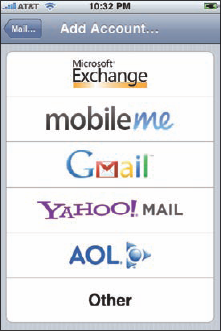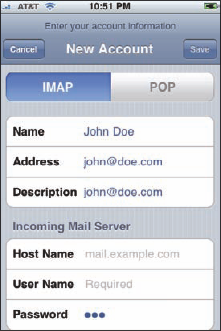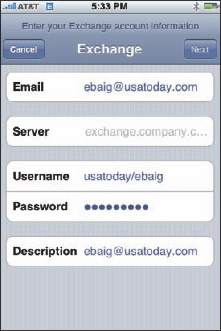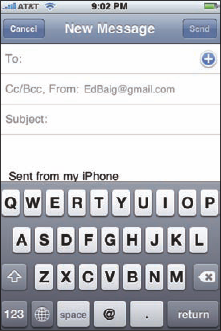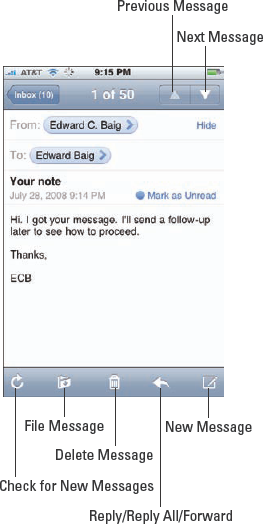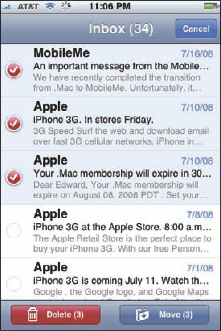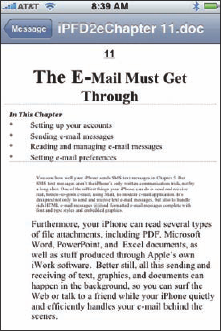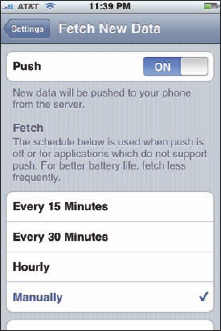Setting up your accounts
Sending e-mail messages
Reading and managing e-mail messages
Searching for e-mail messages
Setting e-mail preferences
Chapter 5 shows you how well your iPhone sends SMS text messages. But SMS text messages aren't the iPhone's only written communication trick, not by a long shot. One of the niftiest things your iPhone can do is send and receive real, honest-to-gosh e-mail, using Mail, its modern e-mail application. It's designed not only to send and receive text e-mail messages but also to handle rich HTML e-mail messages — formatted e-mail messages complete with font and type styles and embedded graphics.
Furthermore, your iPhone can read several types of file attachments, including PDF, Microsoft Word, PowerPoint, and Excel documents, as well as stuff produced through Apple's own iWork software. Better still, all this sending and receiving of text, graphics, and documents can happen in the background so that you can surf the Web or talk to a friend while your iPhone quietly and efficiently handles your e-mail behind the scenes.
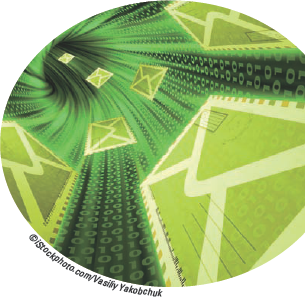
First things first. To use Mail, you need an e-mail address. If you have broadband Internet access (that is, a cable modem or DSL), you probably received one or more e-mail addresses when you signed up. If you're one of the handful of readers who doesn't already have an e-mail account, you can get one for free from Yahoo! (http://mail.yahoo.com), Google (http://mail.google.com), or AOL (http://www.aol.com) or from one of many other service providers.
Warning
Many (if not all) free e-mail providers add a small bit of advertising at the end of your outgoing messages. If you'd rather not be a billboard for your e-mail provider, either use the address(es) that came with your broadband Internet access (yourname@comcast.net or yourname@att.net, for example) or pay a few dollars a month for a premium e-mail account that doesn't tack advertising (or anything else) onto your messages. You can get a me.com e-mail account as part of Apple's $99-a-year MobileMe service.
Chapter 3 explains the option of automatically syncing the e-mail accounts on your computer with your iPhone. If you chose that option, your e-mail accounts should be configured on your iPhone already. You may proceed directly to the later section "Darling, You Send Me (E-Mail)."
If you haven't yet chosen that option but want to set up your account the easy way now, go to Chapter 3 and read that section, sync your iPhone, and then you, too, can proceed directly to the "Darling, You Send Me (E-Mail)" section.
If you don't want to sync the e-mail accounts on your computer, you can set up an e-mail account on your iPhone manually. It's not quite as easy as clicking a box and syncing your iPhone, but it's not rocket science either.
If you have no e-mail accounts on your iPhone, the first time you launch Mail, you're walked through the following procedure. If you have one or more e-mail accounts on your iPhone already and want to add a new account manually, start by tapping Settings on the Home screen, and then tap Mail, Contacts, Calendars, and Add Account.
Either way, you should now be staring at the Add Account screen, shown in Figure 11-1. Proceed to one of the next two sections, depending on your e-mail account.
If your account is with Yahoo!, Google (Gmail), AOL, or Apple's own MobileMe service, tap the appropriate button on the Add Account screen now. If your account is with a provider other than one of these four, tap the Other button and skip ahead to the next section — that is, with one important exception. If you're setting up company e-mail through Microsoft Exchange, skip the next section and read the one after that.
Enter your name, e-mail address, and password, as shown in Figure 11-2. You can describe this account (such as Work or Personal), but the field tends to fill in automatically with the same contents in the Address field unless you tell it differently.
Tap the Save button in the upper-right corner of the screen. You're finished. That's all there is to setting up your account.
If your e-mail account is with a provider other than Yahoo!, Google, AOL, or MobileMe, you have a bit more work ahead of you. You're going to need a bunch of information about your e-mail account that you may not know or have handy.
We suggest that you scan the following instructions, note the items you don't know, and go find the answers before you continue. To find the answers, look at the documentation you received when you signed up for your e-mail account or visit the account provider's Web site and search there.
Here's how you set up an account:
On the Add Account screen, tap the Other button.
Under Mail, tap Add Mail Account. Fill in the name, address, password, and description in the appropriate fields, the same as if you were setting up a Yahoo!, Gmail, AOL, or MobileMe account. Tap Save.
With any luck, that's all you'll have to do, although you may have to endure a spinning cursor for awhile as the iPhone attempts to retrieve information and validate your account with your provider. Otherwise, continue with Step 3.
Tap the button at the top of the screen that denotes the type of e-mail server this account uses: IMAP or POP, as shown in Figure 11-3.
Fill in the Internet host name for your incoming mail server, which should look something like mail.providername.com.
Enter the Internet host name for your outgoing mail server, which should look something like smtp.providername.com.
You may have to scroll down to the bottom of the screen to see the outgoing mail server fields.
Enter your username and password in the appropriate fields.
Tap the Save button in the upper-right corner to create the account.
Tip
Some outgoing mail servers don't need your username and password. The fields for these items on your iPhone note that they're optional. Still, we suggest that you fill them in anyway. It saves you from having to add them later if your outgoing mail server does require an account name and password, which many do these days.
The iPhone has gotten a lot friendlier for business users of late, notably because the device makes nice with the Microsoft Exchange servers that are a staple in large enterprises.
What's more, if your company supports something known as Microsoft Exchange ActiveSync, you can exploit push e-mail so that messages arrive pronto on the iPhone, just as they do on your other computers. (To keep everything up to date, the iPhone also supports push calendars and push contacts.) For push to work, your company must be simpatico with Microsoft Exchange ActiveSync 2003 (Service Pack 2) or 2007 (Service Pack 1). Ask your company's IT or tech department if you run into an issue.
Setting up Exchange e-mail isn't particularly taxing, and the iPhone connects to Exchange right out of the box. There's still a decent chance that you have to consult your employer's techie-types for certain settings.
Start out by just touching the Microsoft Exchange icon on the Add Account screen. Fill in what you can: your e-mail address, username (usually as domainuser), and password. Or, call on your IT staff for assistance.
On the next screen, shown in Figure 11-4, enter the Server address, assuming that the Microsoft Autodiscovery service didn't already find it. That address usually begins with exchange.company.com.
Warning
The company you work for doesn't want just anybody having access to your e-mail — heaven forbid if your phone is lost or stolen. So your bosses may insist that you change the passcode lock inside Settings on the phone. (This is different from the password for your e-mail account.) Skip over to Chapter 13 to find instructions for adding or changing a passcode. (We'll wait for you.) And, if your iPhone ends up in the wrong hands, your company can remotely wipe the contents clean.
After your corporate account is fully configured, you have to choose which information you want to synchronize through Exchange. You can choose Mail, Contacts, and Calendars. Tap each one that you want to synchronize through Microsoft Exchange. After you choose an item, you see the blue On button next to it, as shown in Figure 11-5.
Tip
By default, the iPhone keeps e-mail synchronized for three days. To sync for a longer period, head to Settings and tap Mail, Contacts, Calendars and then tap the Mail account using ActiveSync. Tap Mail Days to Sync and tap No Limit or pick another time frame (1 day, 1 week, 2 weeks, or 1 month).
Warning
Sorry, but if you're moonlighting at a second job, you can configure only one Exchange ActiveSync account per iPhone. If you tap Microsoft Exchange on the Add Account screen of an iPhone that already has an ActiveSync account set up, you get no further.
Now that your account or accounts are set up, let's look at how to use your iPhone to send e-mail.
You see several subspecies of messages: pure text, text with a photo, a partially finished message (a draft) that you want to save and complete later, a reply to an incoming message, and forwarding an incoming message to someone else, for example. The following sections examine these subsets one at a time.
To compose a new e-mail message, tap Mail on the Home screen. You should see a screen that looks pretty much like the one shown in Figure 11-6. Don't worry if yours doesn't look exactly like this or if your folders have different names.
Now, to create a new message, follow these steps:
Tap the New Message button (refer to Figure 11-6) in the lower-right corner of the screen.
A screen like the one shown in Figure 11-7 appears.
Type the names or e-mail addresses of the recipients in the To field or tap the + button to the right of the To field to choose a contact or contacts from your iPhone's address book.
(Optional) Tap the field labeled Cc/Bcc/From:. Doing so breaks them out into separate Cc, Bcc, and From fields. The Cc/Bcc label stands for carbon copy/blind carbon copy. If you haven't used Bcc, it enables you to include a recipient on the message that other recipients can't see has been included. It's great for those secret agent e-mails! Tap the respective Cc or Bcc field to type names. Or, tap the + symbol that appears in those fields to add a contact. If you tap From instead, you can choose to send the message from any of your e-mail accounts on the fly, assuming, of course, that you have more than one account.
Type a subject in the Subject field.
The subject is optional, but it's considered poor form to send an e-mail message without one.
Type your message in the message area.
The message area is immediately below the Subject field.
Tap the Send button in the upper-right corner of the screen.
Your message wings its way to its recipients almost immediately. If you aren't in range of a Wi-Fi network or the AT&T EDGE or 3G data network when you tap Send, the message is sent the next time you're in range of one of these networks.
Sometimes a picture is worth a thousand words. When that's the case, here's how to send an e-mail message with a photo enclosed.
Tap the Photos icon on the Home screen, and then find the photo you want to send. Tap the button that looks like a little rectangle with a curved arrow springing out of it in the lower-left corner of the screen, and then tap the Email Photo button.
An e-mail message appears onscreen with the photo already attached; in fact, the image appears to be embedded in the body of the message but the recipient receives it as a regular e-mail attachment. Just address the message and type whatever text you like, as you did for an all-text message in the preceding section, and then tap the Send button.
Sometimes you start an e-mail message but don't have time to finish it. When that happens, you can save it as a draft and finish it some other time.
Here's how: Start an e-mail message as described in one of the two previous sections. When you're ready to save the message as a draft, tap the Cancel button in the upper-left corner of the screen. Tap the Save button if you want to save this message as a draft and complete it another time. If you tap the Cancel button, you cancel the Cancel command and return to the message and can continue working on it now.
Warning
If you tap the Don't Save button, the message disappears immediately without a second chance. Don't tap Don't Save unless you mean it.
To work on the message again, tap the Drafts mailbox. A list of all messages you saved as drafts appears. Tap the one you want to work on, and it reappears on the screen. When you're finished, you can tap Send to send it or tap Cancel to save it as a draft again.
Tip
The number of drafts appears to the right of the Drafts folder, the same way that the number of unread messages appears to the right of other mail folders, such as your Inbox.
When you receive a message and want to reply to it, open the message and then tap the Reply/Reply All/Forward button, which looks like a curved arrow at the bottom of the screen, as shown in Figure 11-8. Then tap the Reply, Reply All, or Forward button.
The Reply button creates a blank e-mail message addressed to the sender of the original message. The Reply All button creates a blank e-mail message addressed to the sender and all other recipients of the original message. In both cases, the subject is retained with a Re: prefix added. So if the original subject were iPhone Tips, the reply's subject would be Re: iPhone Tips.
Tapping the Forward button creates an unaddressed e-mail message that contains the text of the original message. Add the e-mail address(es) of the person or people you want to forward the message to, and then tap Send. In this case, rather than a Re: prefix, the subject is preceded by Fwd:. So this time the subject is Fwd: iPhone Tips.
Tip
You can edit the subject line of a reply or a forwarded message or edit the body text of a forwarded message the same way you would edit any other text. It's usually considered good form to leave the subject lines alone (with the Re: or Fwd: prefix intact), but you may want to change them sometimes. Now you know that you can.
To send your reply or forwarded message, tap the Send button as usual.
You can customize the mail you send and receive in lots of different ways. In this section, we explore settings for sending e-mail. Later in this chapter, we show you settings that impact the way you receive and read messages. In each instance, you start by tapping Settings on the Home screen. Then:
To hear an alert when you successfully send a message: Tap the Sound icon on the main Settings screen, and then turn on the Sent Mail setting. If you want to change other settings, tap the Settings button in the upper-left corner of the screen. If you're finished setting settings, tap the Home button on the front of your iPhone.
Note
The preceding paragraph is similar for all the settings we discuss in this section and later sections, so we don't repeat them again. To summarize, if you want to continue using settings, you tap whichever button appears in the upper-left corner of the screen — sometimes it's named Settings or Mail or Accounts or something else. The point is that the upper-left button always returns you to the previous screen so that you can change other settings. The same concept applies to pressing the Home button on the front of your iPhone when you're finished setting a setting. That action always saves the change you just made and returns you to the Home screen.
To add a signature line, phrase, or block of text to every e-mail message you send: Tap Settings; tap Mail, Contacts, Calendars; and then tap Signature. (You may need to scroll down to see it). The default signature is Sent from my iPhone. You can add text before or after it, or delete it and type something else. Your signature is now affixed to the end of all your outgoing e-mail.
To have your iPhone send you a copy of every message you send: Tap Settings; tap Mail, Contacts, Calendars; and then turn on the Always Bcc Myself setting.
To set the default e-mail account for sending e-mail from outside the Mail application: Tap the Settings icon on the Home screen, tap Mail, and then tap Default Account. Tap the account you want to use as the default. For example, when you want to e-mail a picture directly from the Photos application, this designated e-mail account is the one that's used. Note that this setting applies only if you have more than one e-mail account on your iPhone.
That's what you need to know about the settings that apply to sending e-mail.
The first half of the mail equation is sending mail, of course. Now it's time for the second half — receiving and reading the stuff. Fortunately, you've already done most of the heavy lifting when you set up your e-mail accounts. Getting and reading your mail is a piece of cake.
You can tell when you have unread mail by looking at the Mail icon, at the bottom of your Home screen. The cumulative number of unread messages appears in a little red circle in the upper-right area of the icon.
To read your mail, tap the Mail icon on the Home screen. The Accounts list appears, and the Inbox in that list displays the number of unread messages in a blue oval to the right of its name.
Tip
If you have more than one e-mail account, you may have to tap the Accounts button in the upper-left corner and then choose the appropriate e-mail account before you see the Inbox with the unread messages.
To see the list of unread messages, tap Inbox in the list of mailboxes and then tap a message to read it. When a message is on the screen, buttons for managing incoming messages appear below it (refer to Figure 11-8).
When a message is on your screen, you can do the following in addition to reading it (all buttons are labeled in Figure 11-8):
View the next message by tapping the Next Message arrow at the upper-right corner of the screen (it's the upward-pointing arrow).
View the previous message by tapping the Previous Message arrow (the one pointing downward).
Check for new messages by tapping the Check for New Messages icon.
File this message in another folder by tapping the File Message icon. When the list of folders appears, tap the folder where you want to file the message.
Delete this message by tapping the Delete Message icon. You have a chance to cancel in case you tap the Delete Message icon by mistake.
Reply, reply to all, or forward this message (as discussed previously) by tapping the Reply/Reply All/Forward icon.
Create a new e-mail message by tapping the New Message icon.
You can delete e-mail messages without opening them in two ways:
Swipe left or right across the message and then tap the red Delete button that appears to the right of the message.
Tap the Edit button in the upper-right corner of the screen, and tap the little circle to the left of each message you want to remove. Tapping that circle puts a check mark in it and brightens the red Delete button at the bottom of the screen. Tap that Delete button to erase all messages you checked off, as shown in Figure 11-9. Deleted messages are moved to the Trash folder.
With the arrival of Spotlight search as part of the 3.0 software upgrade, you can easily search through a bunch of messages to find the one you want to read fast — such as that can't-miss stock tip from your broker. Tap the status bar to scroll through the top of the inbox. You can type stock or whichever search term seems relevant. All matching e-mails that have already been downloaded appear. Or, by tapping in the search box itself, you can display tabs that let you narrow the search to the From, To, or Subject fields. It's too bad that (at press time, anyway) you can't run a search to find words within the body of an e-mail message.
Tip
If you're using Exchange, MobileMe, or certain IMAP-type e-mail accounts, you may even be able to search messages that are stored out on the server. When available, tap Continue Search on Server.
Tip
As we just pointed out, you can delete messages in bulk. In much the same way, you can move them to another folder in bulk. Again, tap Edit and then tap the circle to the left of each message you want to move so that a check mark appears. Tap the Move button at the bottom of the screen (refer to Figure 11-9), and tap the new folder in which you want those messages to hang out.
Your iPhone can even receive e-mail messages with attachments in a wide variety of file formats. Which file formats does the iPhone support? Glad you asked.
Here's the list of file formats that your iPhone can receive as attachments, care of Apple:
Images:
.jpg, .tiff, .gifMicrosoft Word:
.doc, .docxMicrosoft PowerPoint:
.ppt, .pptxMicrosoft Excel:
.xls, .xlsxWeb pages:
.htm, .htmlApple Keynote:
.keyApple Numbers:
.numbersApple Pages:
.pagesPreview and Adobe Acrobat:
.pdfRich Text:
.rtfText:
.txtContact information:
.vcf
Warning
If the attachment is a file format not supported by the iPhone (for example, a Photoshop .psd file), you see the name of the file but you can't open it on your iPhone.
Here's how to read an attachment:
Open the mail message containing the attachment.
Tap the attachment (it appears at the bottom of the message, so you probably need to scroll down to see it).
The attachment, like the one shown in Figure 11-10, downloads to your iPhone and opens automatically.
Read the attachment.
Tap the Message button in the upper-left corner of the screen to return to the message text.
Wait! You can do even more with your incoming e-mail messages:
To see all recipients of a message, tap the word Details (displayed in blue) to the right of the sender's name.
Tip
If all recipients are displayed, the word in blue is Hide rather than Details. Tap it to hide all names except the sender's.
To add an e-mail recipient or sender to your contacts, tap the name or e-mail address at the top of the message and then tap either Create New Contact or Add to Existing Contact.
To mark a message as unread, tap Mark As Unread, which appears near the top of each message in blue with a blue dot to its left. When you do, the message is again included in the unread message count on the Mail icon on your Home screen, and its mailbox again has a blue dot next to it in the message list for that mailbox.
To zoom in and out of a message, employ the pinch and unpinch gestures, which we suspect you excel at now.
To follow a link in a message, tap the link. Links are typically displayed in blue. If the link is a URL, Safari opens and displays the Web page. If the link is a phone number, the Phone application opens and offers to dial the number. If the link is a map, Maps opens and displays the location. And, last but not least, if the link is an e-mail address, a new preaddressed blank e-mail message is created.
Tip
If the link opens Safari, Phone, or Maps and you want to return to your e-mail, press the Home button on the front of your iPhone and then tap the Mail icon.
This final discussion of Mail involves more settings that deal with your various e-mail accounts.
Several settings affect the way you can check and view e-mail. You might want to modify one or more, so we describe what they do and where to find them:
To specify how often the iPhone checks for new messages: Tap the Settings icon on the Home screen; tap Mail, Contacts, Calendars; and then tap Fetch New Data. You're entering the world of fetching or pushing. Check out Figure 11-11 to glance at your options. If your e-mail program supports push and you have it turned on (the On button is showing), fresh messages are sent to your iPhone automatically as soon as they hit the server. If you turned off push (Off is showing) or your e-mail program doesn't support it in the first place, the iPhone fetches data instead. Choices for fetching are Manually, Every 15 Minutes, Every 30 Minutes, and Hourly. Tap the one you prefer.
Tap Advanced at the bottom of the screen (it's not visible in Figure 11-11) to determine these push and fetch settings for each individual account. Tap the account in question. Push is shown as an option only if the e-mail account you tapped supports the feature.
As of this writing, Yahoo!, MobileMe (Me.com), and Microsoft Exchange ActiveSync accounts were awfully pushy (but only in a good way).
To hear an alert sound when you receive a new message: Tap the Sounds icon on the main Settings screen and then turn on the New Mail setting.
To set the number of recent messages that appear in your Inbox: Tap the Settings icon on the Home screen; tap Mail, Contacts, Calendars; and then tap Show. Your choices are 25, 50, 75, 100, and 200 recent messages. Tap the number you prefer.
Tip
You can always see more messages in your Inbox regardless of this setting by scrolling all the way to the bottom and tapping Download More.
To set the number of lines of each message to be displayed in the message list: Tap the Settings icon on the Home screen; tap Mail, Contacts, Calendars; tap Preview; and then choose a number. Your choices are 0, 1, 2, 3, 4, and 5 lines of text. The more lines of text you display in the list, the fewer messages you can see at a time without scrolling. Think before you choose 4 or 5.
To set the font size for messages: Tap the Settings icon on the Home screen; tap Mail, Contacts, Calendars; and then tap Minimum Font Size. Your options are Small, Medium, Large, Extra Large, and Giant. Use trial-and-error to find out which size you prefer. Choose one and then read a message. If it's not just right, choose a different size. Repeat until you're happy.
To specify whether the iPhone shows the To and Cc labels in message lists: Tap the Settings icon on the Home screen; tap Mail, Contacts, Calendars; and then turn the Show To/Cc Label setting on or off.
To turn the Ask Before Deleting warning on or off: Tap the Settings icon on the Home screen; tap Mail, Contacts, Calendars; and then turn the Ask Before Deleting setting on or off. If this setting is turned on, you need to tap the trash can icon at the bottom of the screen and then tap the red Delete button to confirm the deletion. When the setting is turned off, tapping the trash can icon deletes the message and you never see a red Delete button.
To specify whether the phone will automatically load remote images: Tap Load Remote Images so that the on button is showing. If it's off, you can still manually load remote images.
The last group of settings we explore in this chapter deals with your e-mail accounts. You most likely will never need most of these settings, but we'd be remiss if we didn't at least mention them briefly. So here they are, whether you need 'em or not:
To stop using an e-mail account: Tap the Settings icon on the Home screen; tap Mail, Contacts, Calendars; and then tap the account name. Tap the switch to turn off the account.
Tip
This setting doesn't delete the account; it only hides it from view and stops it from sending or checking e-mail until you turn it on again.
To delete an e-mail account: Tap the Settings icon on the Home screen, tap Mail, and then tap the account name. Scroll to the bottom and tap the red button that says Delete Account. You're given a chance to reconsider. Tap Delete Account if you're sure that you want this account blown away or tap Cancel if you change your mind and want to keep it.
The last settings are somewhat advanced and are reached the same way: Tap the Settings icon on the Home screen; tap Mail, Contacts, Calendars; and then tap the name of the account you want to work with. The settings you see under Advanced and how they appear vary a little by account. This list describes some of the ones you see:
To specify how long until deleted messages are removed permanently from your iPhone: Tap Advanced and then tap Remove. Your choices are Never, After One Day, After One Week, and After One Month. Tap the choice you prefer.
To choose whether drafts, sent messages, and deleted messages are stored on your iPhone or on your mail server: Tap Advanced, and then choose the setting under Mailbox Behaviors stored On My iPhone or stored On the Server for Drafts, Sent Messages, and Trash. If you choose to store any or all of them on the server, you can't see them unless you have an Internet connection (Wi-Fi, EDGE, or 3G). If you choose to store them on your iPhone, they're always available, even if you don't have Internet access.
Warning
We strongly recommend that you not change these next two items unless you know exactly what you're doing and why. If you're having problems with sending or receiving mail, start by contacting your ISP (Internet service provider), e-mail provider, or corporate IT person or department. Then change these settings only if they tell you to.
To reconfigure mail server settings: Tap Host Name, User Name, or Password in the Incoming Mail Server or Outgoing Mail Server section of the account settings screen and make your changes.
To adjust Use SSL, Authentication, IMAP Path Settings, or Server Port: Tap Advanced, and then tap the appropriate item and make the necessary changes.
And that, as they say in baseball, retires the side. You're now fully qualified to set up e-mail accounts and send and receive e-mail on your iPhone.

